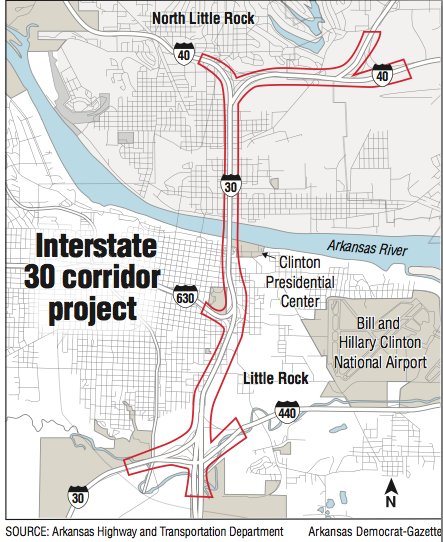The Arkansas Highway and Transportation Department is thinking about other ways to spend the $631.7 million it has identified for the Interstate 30 corridor project in case the project doesn't move forward.
Scott Bennett, the department director, brought up potential contingency plans for the funds at a meeting Wednesday of the Arkansas Highway Commission. A commission member and two others, including a project supporter and a project critic, said the project isn't in doubt and Bennett is just being prudent.
Bennett brought up the possibility of other uses for the money after he said the board of directors of Metroplan, the long-range transportation planning agency for central Arkansas, still has to vote to put the project on both its long-range transportation plan, called Imagine Central Arkansas, and on its transportation improvement plan. Both are required in order for the department to spend federal dollars on the project.
"We're trying to push them as fast as we can go in order to get those approvals in place so we can continue project development," Bennett said. "But because there are a couple of steps that still have to be made, we don't know what's going to happen."
But one member of the Metroplan board, Little Rock Mayor Mark Stodola, said the biggest board hurdle was cleared Aug. 31 when the Metroplan board voted to waive a regionwide policy limiting area freeways to six lanes for the I-30 project.
"I think the big issue we had was over the waiver," Stodola said.
With the exception of an earmark totaling $1.1 million that has to be spent on the corridor, Bennett said, "every bit of that money is flexible" and can be spent elsewhere on the system.
"Because all that money is flexible and because we really don't know what's going to happen in the future with the Metroplan board, we want you to start thinking about what are we going to do if something happens and we don't continue" with this project, he said.
Most of the money identified for the project, $404.3 million, is from the Connecting Arkansas Program. The $1.2 billion program is financed by a half-percent increase in the statewide sales tax that is in place for 10 years, which voters approved in 2012.
That money could be spent on other program projects that are unfunded, Bennett said. They include work on U.S. 270 in Garland County, U.S. 64 in Crittenden County and U.S. 82 in Columbia County.
About $93 million in the I-30 project is from federal bridge replacement funds, which Bennett said could be spent on other eligible bridge replacement projects in the state.
Frank Scott Jr., a member of the commission from Little Rock, said the contingency plans for the money aren't meant to pressure the Metroplan board, which is composed of the region's mayors and county judges.
"This is the reality," he said. "As much as I hate it, [Bennett] has to figure out another plan to use the dollars if it doesn't come to fruition. And we don't need to figure some time in the spring of 2017 that we can't do this project and don't have other alternatives to spend this money.
"That's not pressure. There are folks who say we are pressuring Metroplan and holding things against their head. It's not. We have to spend this money wisely."
Scott said that he expects the project to move forward.
The I-30 project, which the department calls 30 Crossing, is a 6.7-mile corridor that stretches from Interstate 530 in Little Rock to Interstate 40 in North Little Rock and includes a small section of I-40 between I-30 and U.S. 67/167, also in North Little Rock, going through the heart of the heavily developed downtowns of both cities. Both the corridor and its bridge over the Arkansas River, which carries 125,000 vehicles daily, were built 50 years ago.
Engineers developed a preliminary recommendation that the highway should be widened to 10 lanes from six, with two of the new lanes in each direction serving as collector-distributor lanes in the immediate vicinity of both downtowns.
The collector-distributor lanes, designed to serve local traffic, would be separated from the six main travel lanes to allow for vehicles to leave and enter the interstate at slower speeds.
Stodola said Little Rock is moving forward with crafting a joint development agreement between the city and the Highway Department over design elements the city wants in the project for supporting it.
Little Rock has received concessions from the Highway Department that will give the city what the mayor called "an unbelievable park" space created by the elimination of the Second Street interchange on I-30.
The Highway Department has also agreed to design frontage roads using boulevardlike features, he said. Those features include speeds consistent with city streets and wide, tree-lined sidewalks.
Barry Haas, who is part of a group called Improve 30 Crossing that opposes the project as too expensive, unnecessary and a threat to the economic viability of downtown Little Rock, also agreed with Bennett's decision to seek other options on spending the money.
"I would agree it is prudent for the Highway Commission to consider what alternative there is out there to spend the money," he said.
Haas reiterated his contention that, given the "Highway Department's trajectory" on the project, he expects the project development to be the subject of a lawsuit "because they have not offered a realistic option" for the public to embrace.
He contends the environmental review, called an environmental assessment, that the project is undergoing is a less intensive environmental review than federal law requires. His group says the project requires a more in-depth review, called an environmental impact statement.
Metro on 09/15/2016
